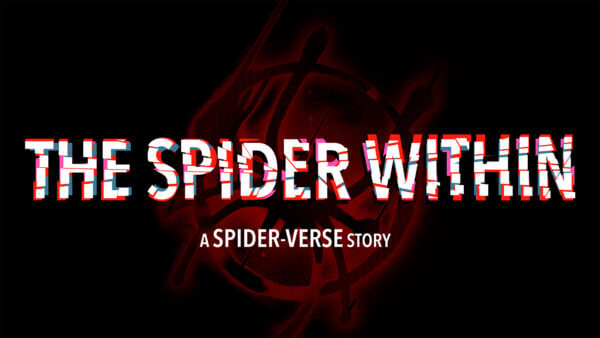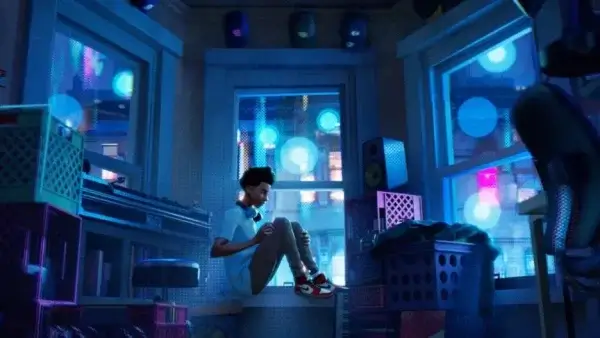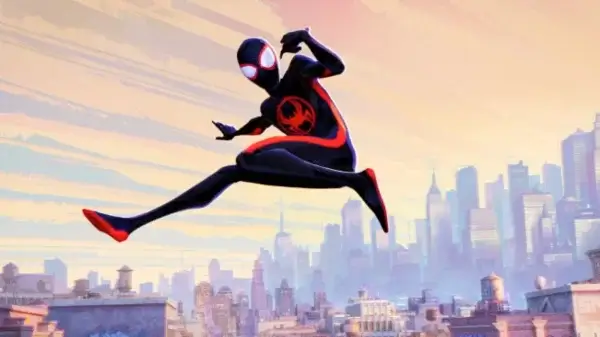The Spider Within | Interview

© Sony Pictures Animation
Franchises as old and successful as Spider-Man are held closely by the studios that own them. When it comes time for the next movie in the franchise, they finally loosen their grasp, first ensuring that the filmmaking team is trustworthy. For movie executives, ‘trustworthy’ usually equates to ‘white’ and ‘male.’ This unwritten Hollywood law made the creation of Sony Pictures’ LENS programme a delightful surprise.
LENS exists to give filmmakers from underrepresented groups a chance to make use of popular IPs and have prestige projects under their belts from an early point in their career. Given the power to make a short film with the Spider-Verse IP was director Jaralle Dampier, writer Khaila Amazan, VFX supervisor Clara Chan and animation supervisor Joe Darko.
Their creation, The Spider Within, is an introspective, horror-tinged deep dive into a panic attack suffered by Miles Morales. The short fleshes out the quiet moments of anxiety that come with the pressure of simultaneously being a teenager as well as New York’s saviour.
Skwigly caught up with the team behind The Spider Within at the Annecy festival to discuss their experience on the LENS project and the challenge of following the exceptional Spider-verse films.
What has been the coolest experience of Annecy so far?
Khaila: The coolest experience has just been feeling the energy of animation fans. The fact that everyone’s here for animation, everyone’s a fan of their own style of animation from different countries was amazing.
Joe: When I got here and just walked out from the hotel and saw all the decorations I could really feel that this town loves animation. Immediately, people I had gone to uni with and like worked with just started popping out of the woodworks. I was like everyone’s here! Waking up this morning was weird because like yesterday was such a cool day. Finally being able to show the short to people and feel that love. When I woke up this morning I was like, Was that a dream? It almost felt so surreal.
Jarelle: Yeah, I didn’t sleep last night. It wasn’t a dream. I think the coolest thing was just when we debuted our short, hearing the audience. This is such a thoughtful group of fans, such a thoughtful group of animation nerds. I felt like these are my people and I haven’t really felt that way a lot in America. America’s just kind of moving and animation is just kind of a thing, but it felt sacred here. It feels special here. It feels different. When you’re promoting a film here, it feels holy almost. It’s an honour.
Clara: Everyone already said everything! It’s the energy and how much love for animation from everyone that came here. That is very special and in the presentation yesterday, it was just really surreal.
There’s a lot of talk about the “Spider-verse style” but that can mean something different to different people. How did each of you go about translating the Spider-verse style to your job on the film?
Khaila: I guess from a writing perspective, I think what’s beautiful is that Spider-verse doesn’t fit the “traditional,” hyper commercial American animation box. No offence to certain types of dying, go and call names. The studios use this term, “four quadrant,” I don’t think that spider verse really fits that either. It’s not for kids, it’s not just for adults, it’s definitely for everyone. It’s not a Marvel movie but it’s not not a Marvel movie. So you’re hitting the tone that the amazing Lord & Miller team created, which is a little rebellious, pushing the boundaries in a lot of ways, being a little edgy. Of course, not scaring children but definitely not hitting certain mainstream commercial elements. And I don’t think that commerciality was the goal, initially, I think it was definitely artwork first, and being innovative and new. If you notice, not to call names, but a lot of the industry is following suit.
Jarelle: I would say that my answer to this would be different before Across the Spider-verse came out, because I’m starting to see that the team that makes these movies, they’re just interested in pushing and evolving the medium. Even in the second film, I don’t think they were so beholden to the first film that they weren’t willing to expand, and you get those incredible moments in Gwen’s world and you get the incredible moments in Mumbattan and it’s insane. Imagine if they just stopped at what they did on the first movie. I think a lot of people thought, how can they top that? I thought that too. And I think that like with the short, it was just a matter of honouring the films more than anything, it wasn’t so much that we were trying to be so different from the films themselves. We wanted to take the same spirit of rebelliousness that Lord & Miller kind of set a trend for. And I felt like we could do something that was disruptive, in the medium of short films, but honoured the main films that came before it and that we’re standing on the shoulders of.
Clara: Visually, it had to feel like the Spider-verse movie. We had that as our guide. And it’s always comic book inspired. So we have all the traditional screen tones and other chromatic aberrations. Those are pretty much using the same tools and rules as the first movie. And then what we pushed is the more extreme colours.
Joe: Animation-wise, I think it boils down to seeing the artists’ hand in the work. Both the first Spider-verse and the second rely on the frames being so designed, like the animators sculpt almost every silhouette, especially in the second one. We were literally sculpting every single silhouette on every frame. And then we would be drawing over it for effects and things like that. It really is about this comic book world and making it so when you’re looking at those frames, you feel the love on so many levels. Like someone’s thought about the performance but someone’s also thought about the shape, someone’s thought about how that outline is gonna look.
The way you would handle fast action in Gwen’s world, that’d be more like water-coloury streaks, versus Miguel having more sharp edged spheres and things like that. But they’re all based on finding that artist angle. And for Mumbhattan, for example, they looked at old Indian comics and how the colour bleed on those would be different to the Marvel western comics, and that’s how that world got its look. So essentially, knowing all this, I tried to take some of those concepts when I was working on the short. Early on Jarelle and Khaila had laid down thriller and horror as genres and interests that they wanted us to explore in the short and so I was also thinking like, “how can we combine like something you might see in a scary movie into comic books, and I looked at some scary comic books as well to see how they handle line work differently and things like that. So that was all the research.
Miles interacts with something like a shadow version of himself in the short. This character is pitch black, how does that work lighting-wise?
Clara: It’s tricky. Sometimes you have to cheat a little bit. Even though it’s a dark corner, if you want the shadow to stand up, you have to add a little bit brightness behind it. You just have to add enough for that separation, but you don’t feel like it’s all suddenly bright. So it’s really fine tuning.
As an audience member you can think “okay there’s a street lamp outside” or something.
Khaila: That’s the thing I learned from Clara is like, it has to have logic. Because it’s animation, I’m like, “Oh, why not just change colour?” And it’s like no, there has to be a real light source. So they’re treating it like a live-action set. And then the layout. I remember there was a time, as a writer, they were like, “Oh, the rooms aren’t big enough.” In my mind, I’m like, “Well, can you just make the room bigger?” And it’s like, oh, no, we have the size of a room. They’re like these are actual dimensions that exist. And that blew my mind. What’s great is that every time we wanted to, let’s say, make a spider bigger or hit an angle or shot, Joe’s like “well, how do we cheat it? How do we cheat the angle? How do we move his bed back? Maybe it’s only for two seconds you see the size of the room increase.” So I learned a lot from them.
Miles suffers a panic attack in the short and immediately runs to his headphones, which is something I can relate to. What’s everyone’s go-to album in a moment of anxiety?
Jarelle: Well, the Across the Spider-Verse soundtrack is on constant rotation, it’s just a beautiful soundtrack. Other than that, I listen to a lot of either movie scores or calming meditation sounds. It kind of helps you to relax a little bit and stay focused?
Khaila: So I do two things. One, my brother’s a musician, his name is Deann Rene, and so I play his music because it feels like home a little bit. And then I also play a lot of rhythmic, smooth kind of Afro beats. It makes me feel like I’m in another country, because like another thing with anxiety, you just don’t want to be where you are. Gotta be somewhere else, so I put on music from another language.
Clara: I don’t listen to music very often, I learned what Lo-Fi means from these guys. But once in a while I will listen to my old 90s Hong Kong records.
Joe: I love music. Like we were at dinner the other day, and we’re talking about our inside voices and I was like, I just have music. If I’m feeling a little low, usually I’ll play something a bit more silly to make me chill and remind me of the silliness of life. I do swing dancing and I’ll play some jazz swing songs that usually have the silliest lyrics.
Khaila: That’s such a good question, though. Because music is such a big component [of the Spider-verse films]. It looks like we all go to music for some form of comfort, just like Miles did.
Jarelle: I do think that all of our musical influences have shown up in the short in a weird way. Lo-Fi especially. When I’m having a hard day I listen to Kpop a lot. I think we just have the most random assortment of interests and I think that unique perspective from all of us, it allowed us to push in very specific areas that gave to the short. And I love that. Now that I’m hearing everyone describe their tastes, I can see how those tastes showed up.
Khaila: One last thing about the Lo-FI, you know the Lo-Fi girl? That’s an Easter egg in the development process, we drew a lot of inspiration, I think, at least from the aesthetics of Lo-Fi. So when you come home, a lot of people just put chill beats on and sit by their window. So if you compare the framing, it looks a little similar.
I think it’s self explanatory why a programme like LENS needs to exist, but could you explain how rare it is to find opportunities like this?
Jarelle: Oh my gosh, I don’t know if I would have directed for five more years without something like this. It just takes forever and there’s a limited amount of things to direct. It’s not like there’s hundreds of things going on all the time. This was something I was hoping would happen. It’s something that I often journal about, something I talked to my wife about. It’s something that I would voice interest in at the studios that I would work at. But it did seem like this weird unpaved road with no real end or no real way to get there. It’s just “stick around, kid, and one day, you’ll be trusted with the reins.” And I just thought that was the way and when the email came about this, I thought it was a scam. I don’t know if anyone else thought that but I literally asked, “Is this a scam?” Speaking of Justin shells, and he was like, it’s not a scam. That’s how that’s how rare these opportunities are. They’re so rare that I felt like I was being tricked. That says something about the state of things.
Khaila: In my case, it was pivotal in two key ways. One, I was a comedy writer at the time, and I love that they trusted me enough to write this horror thing. So it was helpful to get to have a playground of genre. And then secondarily, the realm of superheroes, I think a lot of people want to be in there. But it’s like, how do you get that first step of that first opportunity? And thankfully, now I have a Spider-verse project underneath my belt and that’s opening doors already to be trusted with an expansive world. So I think it was incredible to be trusted with an old, long-standing IP, a multimillion dollar franchise, and being able to play with genre in it.
Clara: According to statistics, only 0.5% of VFX supervisors are women of colour.
Jarelle: And 0.25% of that is Clara.
Clara: [Laughs] yeah we’re very rare.
Joe: For me, the way it works on the “animation ladder” is you have your teams of 50 to 100 in animation, and then you get to the first level, which is lead animators, and it goes down to a two digit number, and then you get up to the next level, in animation supervisors, or head of animations who are very limited, because you only need one per project. So essentially, a studio would have a handful of head of animations. That’s a pretty big job which comes with a lot of experience so they don’t tend to let them go. As an animator looking to move up to that role, you can be looking to wait around for a while until someone leaves the company.
Beyond that there are loads of other experienced artists in the studio. For me, I knew supervising was something I always wanted to do because I love exploring characters and acting and all that stuff. But the reality of it is I don’t expect to actually be able to do it for at least another 10 years, personally. And also to get to the point where you can do it, usually it’s a thing where you have to prove you’re already basically doing it without the title for a while and then you eventually get it.
Khaila: It’s just skewed against underrepresented groups. Do work for free and we’ll see.
Joe: It was such a nice space for me because I can try out this role and see what it’s like, see if I like it and if I happen not to, it’s early, it’s within a manageable timeframe.
Khaila: And it was with black characters. So not only was it superhero, not only is it paid, not only is it a great group of people that I can relate to. We’re feeling free and able to work with people that reflect our identities. It was just a great experience.
Jarelle: And I think we did a pretty good job.
Khaila: Yeah. Even if it was an epic fail, I would have been happy.
Jarelle: I’m proud of it. I think it just shows that ability and talent can come from anywhere. Don’t sleep on the people around you because I feel like animation can get a little political. There can be some “you just haven’t put the time in” and “there’s other people in line before you” and all that stuff makes sense. But don’t sleep man, we got stories to tell.
The Spider Within: A Spider-Verse Story will screen at this year’s Animation is Film festival on October 21st



